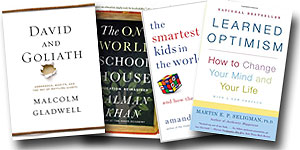Book Reviews – Gladwell, Khan, Ripley, and Seligman
Book Reviews – Gladwell, Khan, Ripley, and Seligman
Like most of you, I’m working on 2 or 3 books at any moment because outside of the “mental Chinese food” from the likes of Baldacci, Grisham and Cussler, I find it hard to grind through a single book in one sitting.
That brings me to 4 Non-fiction books that held my attention, made my mind race and brought me back for re-reading: David and Goliath: Underdogs, Misfits, and the Art of Battling Giants from Malcolm Gladwell; The One World Schoolhouse: Education ReImagined by Sal Khan; The Smartest Kids in the World and How They Got That Way by Amanda Ripley; and an older title, Learned Optimism: How To Change Your Mind and Your Life by Martin E. P. Seligman.
This won’t be a detailed review or criticism of the books. What I was drawn to were some of the links between all 4 books. Specifically, the grit required to make change, the way that small improvements over time add up to big results and the role of challenging common wisdom in overcoming the status quo. I’ll race through these topics for you.
Before I do that, if you haven’t picked the books up here are some simple summaries:
David and Goliath: Gladwell challenges what we think of as “advantages” and “dis-advantages” using stories of underdogs and desirable disadvantages with unusual outcomes.
One World Schoolhouse: Khan tells his story and outlines his vision for global education.
Smartest Kids: Ripley views the challenges in the US education system through stories of 3 US exchange students that spent a year in “high functioning” education systems.
Learned Optimism: Seligman takes us through his 20+ years of research on how optimism makes life better.
The Grit theme, as I’m defining it is “perserverance and passion for long-term goals”. It’s a theme that showed up from book to book. The “sticktuitiveness” that some people have in seeing a task to completion. From Sal Khan working out of his closet to pursue his vision of a world class education being available to anyone with an internet connection, to Seligman’s stories of his work in recruiting for MetLife, there was an underlying theme of persistence and vision that permeated all four works.
As a side note, the Seligman optimism/pessimism test was a real eye opener. Especially when those results were played out against his studies with MetLife in the late 80’s. I used to think of myself as a dyed in the wool optimist but found out that I’m just slightly optimistic. Seligman’s experience with MetLife brought my own experience selling for Northwestern Mutual Life back into focus. If he had done the tests with NML or if I had interviewed at MetLife, those 3 years might have been much different! That test is worth the price of the book alone. (used on Amazon is under $4)
That brings me to the second theme: small improvements add up over time. The stories from Amanda Ripley told us about one of the most respected education systems in the world, Finland. In it, we hear about teachers that have been elevated in societal standing through years of rigorous training and selection. In outlining his vision for the future, Sal Khan lays out the world of the new Teaching Technologist who relies on data to optimize the learning process. Seligman tells story after story of cognitive behavioral therapy wins and Gladwell tells the story of dyslexics that hone their communication skills to dominate their fields. They all struck me because they were examples of small improvements that add up to big results over time. I just did a bit on 1% improvement adding up via compound interest using the example that $100 compounding at 1% earned interest a day is over $3K by year end. Impressive, I know.
The bigger point is that it’s hard to see small improvements because we are so focused on immediate results. 1% improvement is such a tiny thing for most of our endeavors. So small that it’s hard to define how we would even measure it. But like a Finnish policy change in the 70’s, if you have the patience/grit, larger results will eventually show up. Or, like Khan lays out, a revolutionary improvement in education happens with small optimizations. Don’t be distracted by the exceptions (“but what about so and so?!?”) – keep your focus on the small improvements and eventually you’ll make change.
Which brings me to the last point. Contrarian thinking. Gladwell spends the most time on this but you could argue that the 3 other books were about the same thing. Khan used widely available, open source technology to educate hundreds of thousands of people from his closet, Ripley shows examples of big results coming from countries that think differently about education than we do and Seligman was at the forefront of proving that how we talk to ourselves can have a measurable impact on our lives. That said, my takeaway on contrarian thinking is this: the people that challenge the status quo and take the heat are often rewarded with outsized results. The challenge is bucking conventional wisdom. Which isn’t easy to do.
But you know that.
Overall, these are 4 books that are on the shelf and ready for lending. I read them all in hardcover because I still love the feel and I’m not kidding, if you’re interested in borrowing one of these titles, let me know. I can make that happen.
Good stuff.
About the Author: Greg Chambers is Chambers Pivot Industries. Get more business development ideas from Greg on Twitter.

